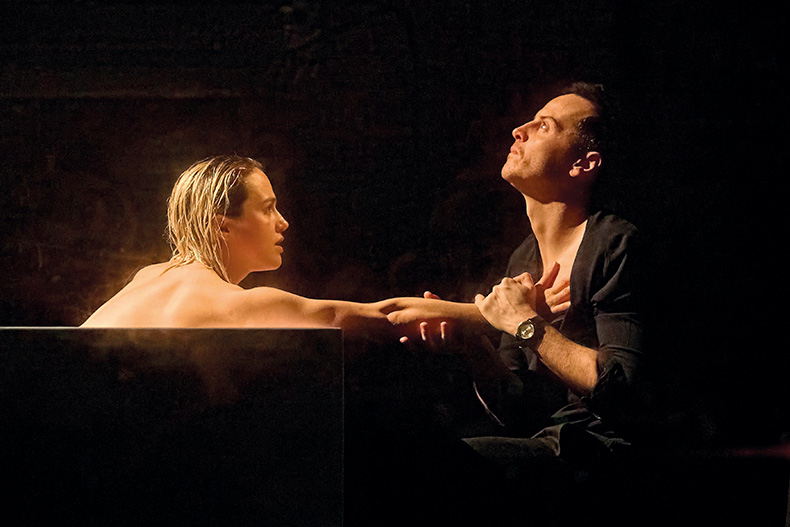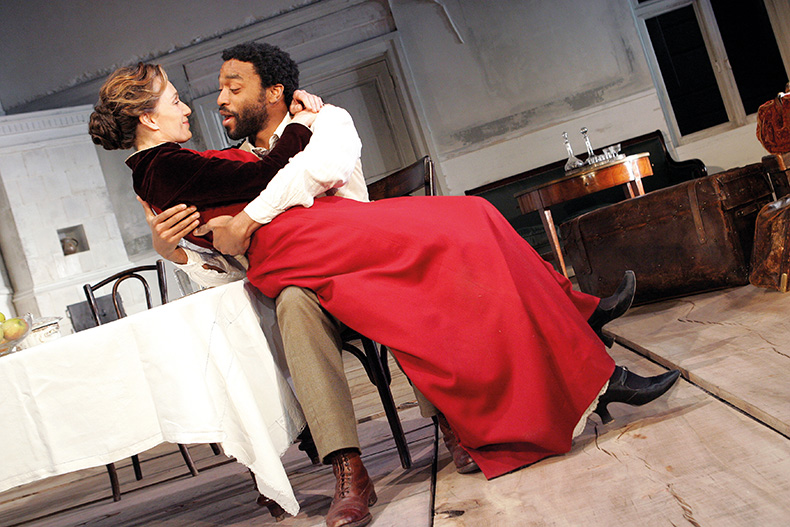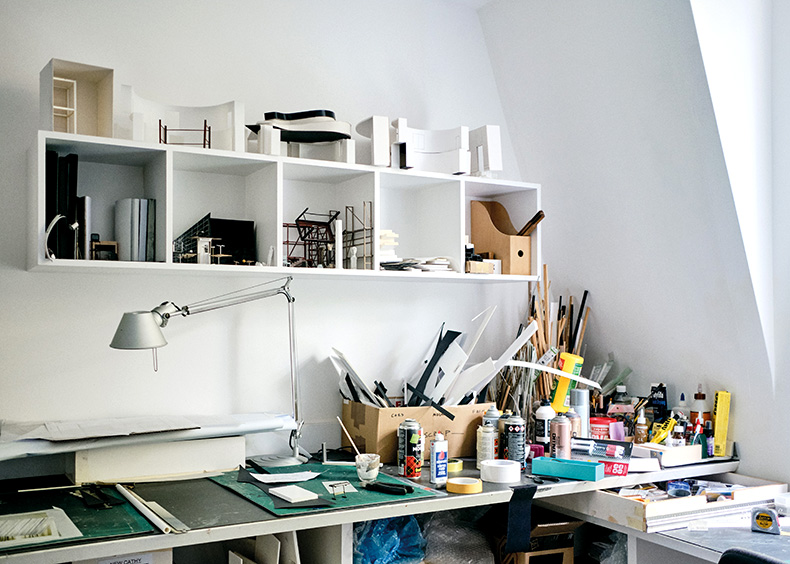From the July/August 2024 issue of Apollo. Preview and subscribe here.
At the end of our interview, as Hildegard Bechtler is being photographed, we start chatting about Margaret Howell. ‘Have a look at the book on the coffee table, the one with the photographs of Georgia O’Keeffe,’ she says. ‘If you want to talk about influence, there is definitely something going on there.’ In a way, this is typical of Bechtler, to make a connection between the designs of Margaret Howell and the clothes worn by Georgia O’Keeffe. The set designer has built a storied career over the past 50 years by creating worlds. She does so by allusion, picking up images from the world around her and presenting them afresh to illuminate the world on stage. When it works well, the illumination travels both ways – we discover as much about the world we live in as the one being created.
Bechtler arrived in England from Stuttgart, where she grew up, in 1973. She went first to Camberwell College of Arts to get an English qualification so that she could attend art college as an undergraduate. It was there that she was taught by the painter Sargy Mann (1937–2015). Bechtler remembers him with something much more rigorous than fondness: he was ‘the fantastic tutor at Camberwell, and a wonderful painter, but he was going blind at the end and for years he painted entirely blind, by touch.’
Bechtler is a conversationalist of some genius, and as the stories spool out of her, it becomes clear that London wasn’t only a place of study. When she says, of her arrival in this country, ‘it was, of course, the best time to arrive in London, I mean I was at the [Rolling] Stones playing that year. It couldn’t have been more wonderful,’ you quickly get the sense that her education was happening outside the classroom as much as within it. ‘As soon as I arrived, I thought “I’m not going back”. It was as simple as that.’
Mann continued to be Bechtler’s tutor throughout her foundation course at Camberwell, a college where ‘they did everything’. By the time she had completed the course, she had become determined to study stage design, taking up a place at Central Saint Martin, despite the best efforts of Mann and the painting department at Camberwell to keep her. ‘They said, “You’ve got to continue painting, you’re a painter.”’ But Bechtler felt otherwise. She says, matter-of-factly, ‘I didn’t have whatever it takes to be a painter, I didn’t have that because I didn’t want to be left alone, with myself. I wanted conversations, I wanted people, I wanted the play.’ For the next decade, Bechtler found herself living in Soho opposite the stage door to the Piccadilly Theatre, falling deeper and deeper into London’s theatreland – a place full of conversations and people.

Jessica Brown Findlay and Andrew Scott as Ophelia and Hamlet in Hamlet, directed by Robert Icke and designed by Hildegard Bechtler, at the Almeida Theatre, London, in 2017. Photo: Manuel Harlan/ArenaPAL
It is hard to make generalisations about set design over the past 40 or 50 years. For every entirely abstract set there is a work of unbridled realism, for every Sally Jacobs there is a Bunny Christie. You might think that Bechtler, who trained in art, would have built her career on paint effects and scenic art. But that could not be further from the case. ‘I can’t actually do scenic artists’ work,’ she says. ‘I couldn’t, it doesn’t interest me at all.’ But it does mean that she can have a ‘very precise’ talk with scenic artists to discuss finishes. It’s possible that this becomes more important as scenic artists become rarer and rarer. ‘Computers have taken over,’ she says. In Bechtler’s studio, at the top of her house in north London with windows at either end and the soothing sound of wind in the trees, there is no evidence of a computer. Instead, there are all the tools and materials required to make detailed model boxes – themselves becoming quite an old-fashioned way of presenting stage designs. Miniature hospital beds and surgical lights are strewn across the table next to perfectly cast recycling bags in green plastic and models of actors in striking poses, from Kristin Scott Thomas reclining with a pair of blood-red high heels to a semi-naked man squatting down, can of lager held high as he crouches to do god knows what. For Bechtler, the model is essential. ‘I’m very precise,’ she says, ‘and the production team can just look at the model and build it.’
Electra, for the Royal Shakespeare Company in 1988 in the Pit at the Barbican, was the production that really made Bechtler’s name. The studio theatre is not a beautiful space by any stretch of the imagination but it was the start of a long collaboration with the director Deborah Warner and the actor Fiona Shaw that defined a certain strand of British theatre throughout the 1990s. One of the astonishing things about Bechtler’s career is how she maintains these creative partnerships. ‘I keep working with the same people,’ she says, ‘I’ve done that all along. I worked with Tim Albery, I worked with Deborah Warner for decades. I’ve worked with Robert Icke for a decade any second from now.’ She has, she notes, never asked anybody to work with her; they’ve always come to her.
Perhaps the best-known example of Bechtler’s work with Shaw and Warner is Richard II at the National Theatre (1995). Shaw was one of the first modern female performers to take on the effeminate king. With her wit and bound body, it was a performance that is now legendary, though it was slated by many critics at the time. The set, a traverse stage made of plywood and brass, but with heavy felt cloth, was one that Bechtler struggled with at first. ‘I was stuck,’ she says, ‘but my breakthrough came when we changed the seating to make it very steep – it felt very Elizabethan. And then we had this channel [the stage] and I just used real materials, which I love doing. It was just plywood and brass, treated like it was old, along one wall […] and you lifted the ply and there was earth for whenever it was the garden. But these materials, in an abstract way, could take you specifically, in a material way, to Elizabethan [sensibility] without having to do anything.’
What becomes clear, talking to Bechtler, is how important matching materials and images is to create the right feeling for a play. One of the productions she worked on that I remember best is Ian Rickson’s version of The Seagull at the Royal Court in 2007. The main thing people talked about was the extraordinary cast: Kristin Scott Thomas, Mackenzie Crook, Chiwetel Ejiofor and Carey Mulligan. The Court is a difficult stage: it is narrow and on one side there’s very little wing – you’re up hard against the architecture of the building. The challenge for Bechtler was to ‘make these rooms feel alive’. She asked the technical director if they could ‘buy a couple of trees and lay our own floor’. He agreed.

Kristin Scott Thomas and Chiwetel Ejiofor as Arkadina and Trigorin in The Seagull by Anton Chekhov, directed by Ian Rickson and designed by Hildegard Bechtler, at the Royal Court, London, in 2007. Photo: © Tristram Kenton
Bechtler wanted the floorboards to be wide, ‘because there’s something about lands, about Russian landscape, and there is something about nature.’ It was her way of bringing in ‘the usual trees’ but in a different way. The floorboards were so large they had to be turned each night so they didn’t bow. ‘People probably didn’t realise but the floor did things, it’s emotional.’ There is something poetic about taking a traditional symbol of Chekhovian Russia and making it fresh, reworking it to create not an image but a feeling.
Most of the design process seems to consist of conversation. Bechtler relies on meetings with directors in which they work together to solve the problem of the play. Part of it is practical but it goes beyond that. One reason she and Warner worked together for a decade is because Warner ‘was somebody who said the right things’. When they met to discuss Electra, Warner told Bechtler that she was thinking of the title character as somebody who rolls her own cigarettes; perhaps, she added, there was milk in vast metal containers on stage. ‘None of that happened,’ Bechtler says, ‘but it catapults you into a very different direction.’
Conversation is both the engine and where it starts. If a director wants to work with Bechtler they had better ensure that they have prepared properly. Trevor Nunn had one ‘wonderful, wonderful conversation’ with her about The Merchant of Venice at the National (1999), which was lucky as his obligations as the theatre’s artistic director meant that Bechtler didn’t get much more time with him. When they transferred the production from the small studio space then known as the Cottesloe to the theatre’s largest stage, certain things had to change. Bechtler wanted to introduce a wall to help with the staging. She asked the production team to build it and it was only on the evening of the technical rehearsal that she begged Nunn to think about using it. The next morning he agreed. (I suspect Bechtler usually gets her way, mainly because she is right.)
It was a conversation with her latest collaborator, Robert Icke, that started their working relationship too. As an associate at the Almeida, Icke was talking to designers about his production of the Oresteia (2015). ‘I immediately felt, yes, I want to do this. I’d never seen anything he’d done but both of us understood the way we were talking about the play. You could go in any direction and somehow it seemed to bring things up which started the next thing. It was what I call a good conversation,’ she says. The result was a boldly clinical set, all glass and hard surfaces for Icke to impose his vision of the play upon, the story translated into a terrifying criminal case to be judged.
Bechtler is currently working with Icke on a production of Don Giovanni for the opera festival at Aix-en-Provence. She has designed it before, at Glyndebourne for Warner, but this feels quite different. For opera there is another voice in the conversation, as the starting point has to be the music. ‘The music inspires,’ says Bechtler. And while you have to match the music in the design, ‘people are supported by the music’. Icke is ‘very interesting to listen to the music with’; it’s clear from how Bechtler describes the process that with opera, it’s the music that opens up the conversation.

A model box containing Bechtler’s set designs for Don Giovanni at the Aix-en-Provence opera festival. Photo: C.L. Proctor
Of course, you eventually have to bring the conversation round to something concrete. ‘I love imagery,’ Bechtler says. Referring to her design for Hamlet (2017), which she also did with Icke, she says, ‘I can show a director a woman, say, for a scene, cowering behind a sofa or in a bathtub with the head hanging out, a wonderful photo taken by somebody interesting, and there’s something in that emotionally that is so right that it might find its way into getting re-enacted. There might be an actress behind a sofa – in fact, that happened. And also we had a bath, just for a moment.’ It’s that magpie tendency of filing away images and influences and bringing them out to create emotion, to create a world that actors can inhabit, that is the stuff of Bechtler’s design.
As I think about our own conversation, I wonder why talking is an intrinsic part of the process. Not everyone can exchange ideas so freely and still produce tangible results. But then I remember what Bechtler said at the start of our interview about why she came to England. ‘I was born in 1951. This was the period when no one talked about what had just happened,’ she says. ‘I wanted questions answered. There was quite an anger among that generation. In school, in society, in the home, nobody discussed any of it.’ Things weren’t much better in England – ‘when I arrived in England it was this horrible baddies/goodies’ – but ‘it was for the deepest reason I left, I didn’t like it there.’ Bechtler might have devoted her life to creating the background for things that didn’t really happen but in all the conversation, the interrogation, the pinning down, perhaps what she is really getting to is the truth. Rather than building sets, she’s using conversation to bring into the light so much of what is left invisible.

Hildegard Bechtler’s workroom, part of her studio in north London. Photo: C.L. Proctor
From the July/August 2024 issue of Apollo. Preview and subscribe here.















![Masterpiece [Re]discovery 2022. Photo: Ben Fisher Photography, courtesy of Masterpiece London](http://zephr.apollo-magazine.com/wp-content/uploads/2022/07/MPL2022_4263.jpg)
‘Like landscape, his objects seem to breathe’: Gordon Baldwin (1932–2025)